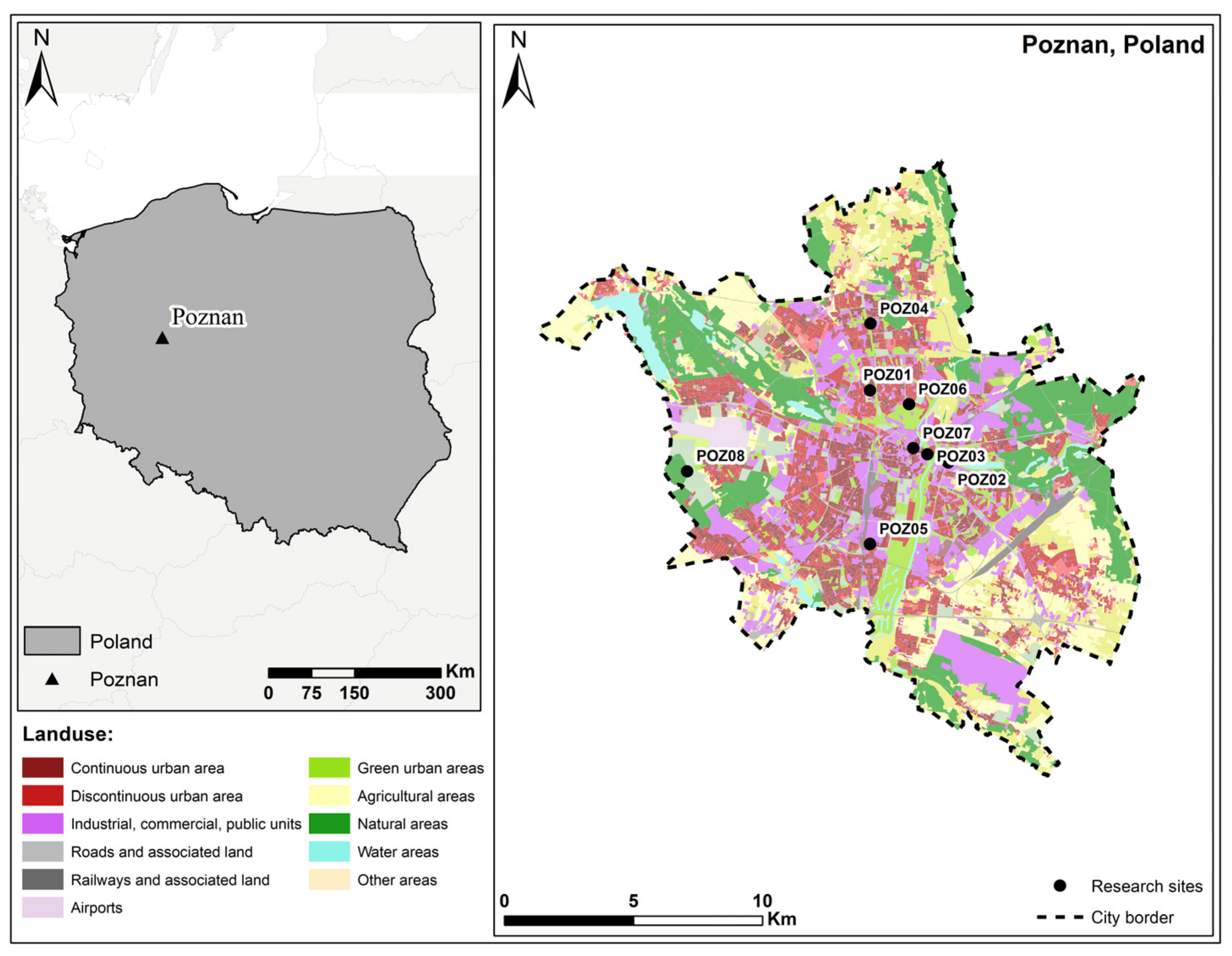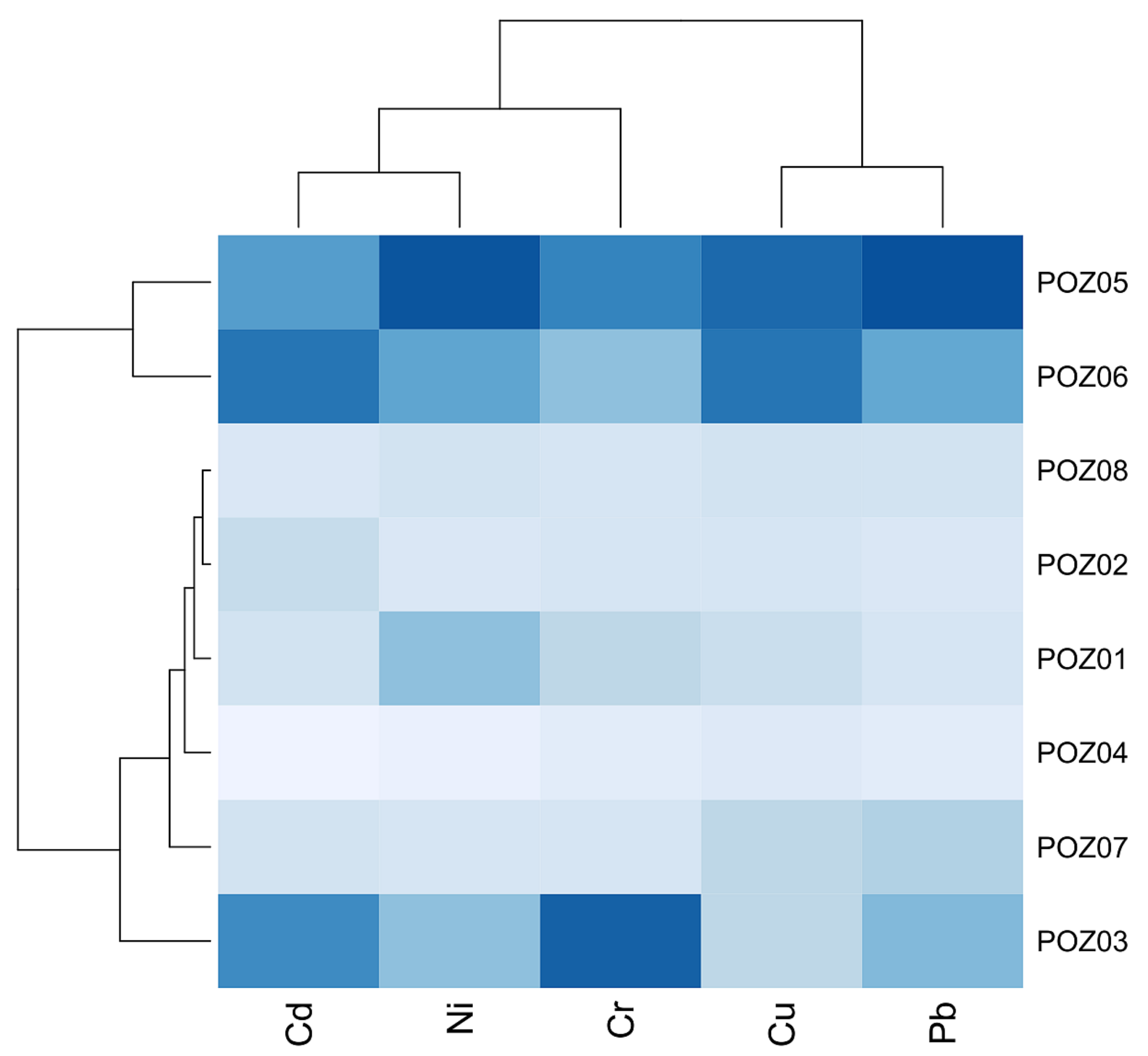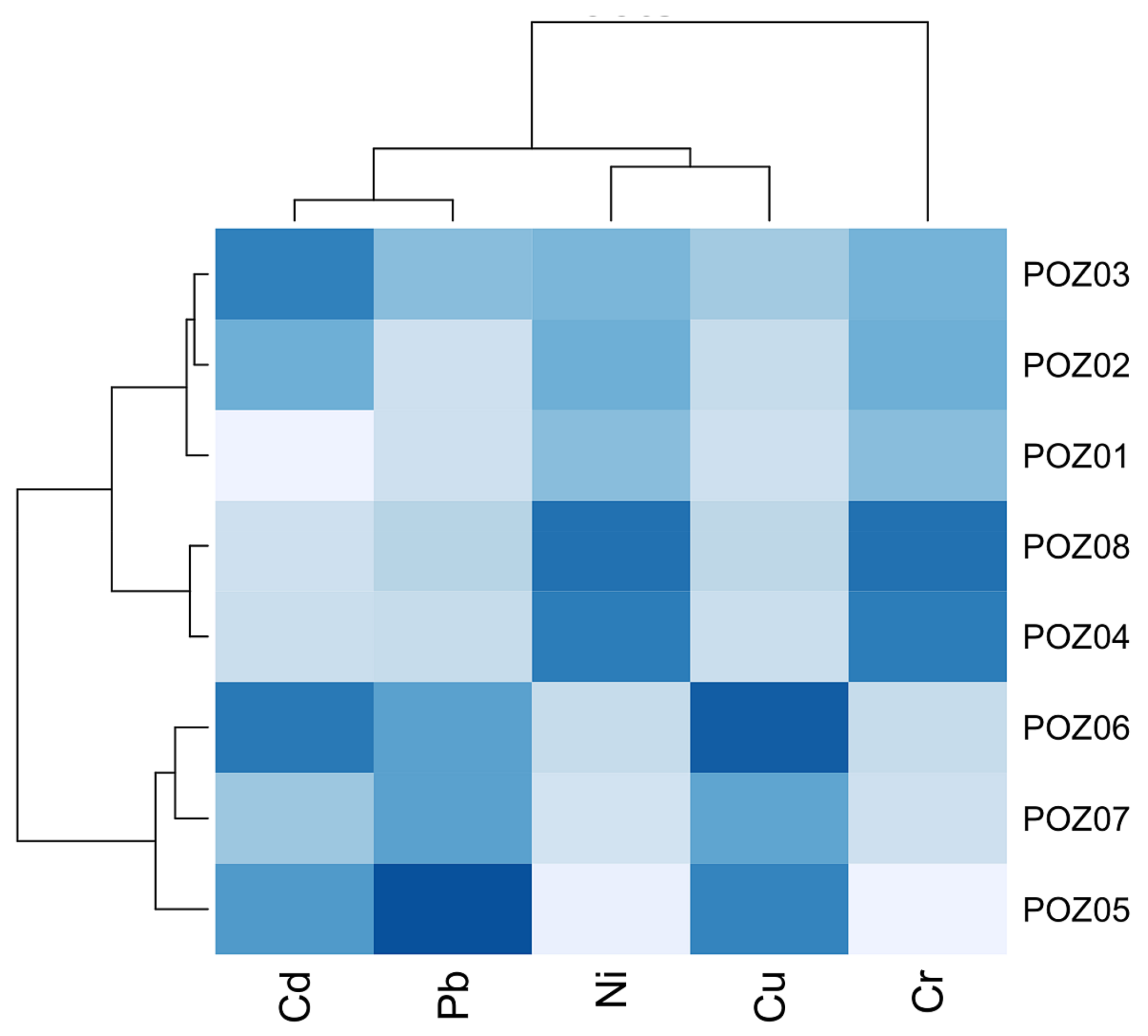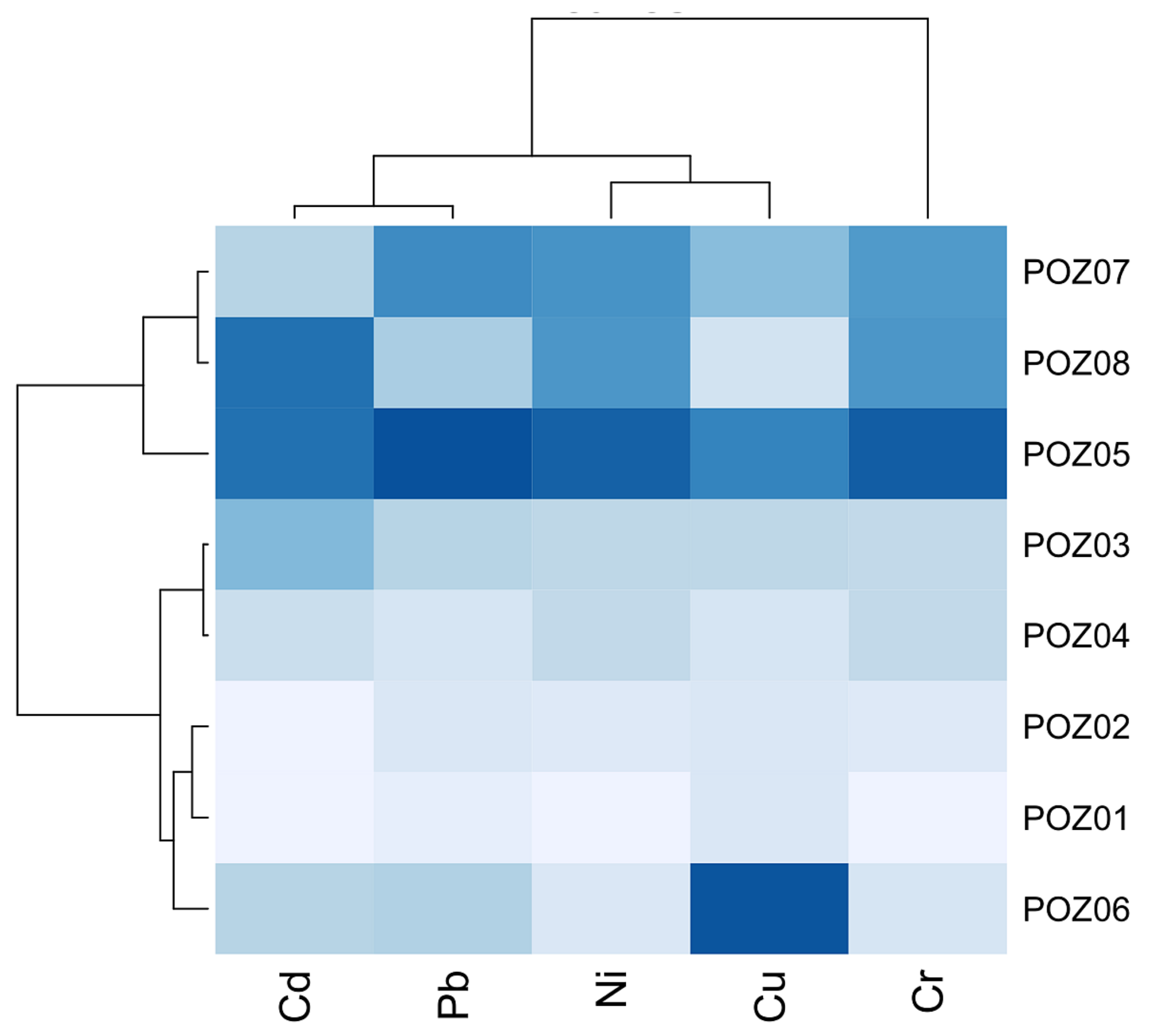Trifolium pratense and the Heavy Metal Content in Various Urban Areas
Abstract
1. Introduction
2. Materials and Methods
2.1. Study Area
2.2. Experimental Materials
2.3. Soil and Plants Sampling
2.4. Sample Preparation and Digestion Procedure
2.5. Heavy Metal Determination
2.6. Quality Assurance
2.7. Ratios of Accumulation, Translocation and Contamination
- CF < 1—LCF—low contamination factor,
- 1 ≤ CF < 3—MCF—moderate contamination factory,
- 3 ≤ CF < 6—CCF—considerable contamination factor,
- CF ≥ —VHCF—very high contamination factor [49].
2.8. Statistical Analyses
3. Results
3.1. Soils Characteristics and Concentration of Heavy Metals in Soils
3.2. Content of Heavy Metals in Plant Roots
3.3. Content of Heavy Metals in Plant Leaves
3.4. Bioconcentration (BCF), Translocation (TF) and Contamination Factor (CF)
4. Discussion
5. Conclusions
Author Contributions
Funding
Institutional Review Board Statement
Informed Consent Statement
Data Availability Statement
Acknowledgments
Conflicts of Interest
References
- Rucandio, M.I.; Petit-Dominguez, M.D.; Fidalgo-Hijano, C.; García-Giménez, R. Biomonitoring of chemical elements in an urban environment using arboreal and bush plant species. Environ. Sci. Pollut. Res. 2010, 18, 51–63. [Google Scholar] [CrossRef] [PubMed]
- Sawidis, T.; Breuste, J.; Mitrovic, M.; Pavlovic, P.; Tsigaridas, K. Trees as bioindicator of heavy metal pollution in three European cities. Environ. Pollut. 2011, 159, 3560–3570. [Google Scholar] [CrossRef] [PubMed]
- Wong, C.S.; Li, X.; Thornton, I. Urban environmental geochemistry of trace metals. Environ. Pollut. 2006, 142, 1–16. [Google Scholar] [CrossRef]
- Briffa, J.; Sinagra, E.; Blundell, R. Heavy metal pollution in the environment and their toxicological effects on humans. Heliyon 2020, 6, e04691. [Google Scholar] [CrossRef] [PubMed]
- Malizia, D.; Giuliano, A.; Ortaggi, G.; Masotti, A. Common plants as alternative analytical tools to monitor heavy metals in soil. Chem. Central J. 2012, 6, S6. [Google Scholar] [CrossRef] [PubMed]
- Tangahu, B.V.; Sheikh Abdullah, S.R.; Basri, H.; Idris, M.; Anuar, N.; Mukhlisin, M. A Review on Heavy Metals (As, Pb, and Hg) Uptake by Plants through Phytoremediation. Int. J. Chem. Eng. 2011, 2011, 939161. [Google Scholar] [CrossRef]
- Ali, H.; Khan, E.; Ilahi, I. Environmental Chemistry and Ecotoxicology of Hazardous Heavy Metals: Environmental Persistence, Toxicity, and Bioaccumulation. J. Chem. 2019, 2019, 6730305. [Google Scholar] [CrossRef]
- Mahurpawar, M. Effects of heavy metals on human health. Int. J. Res. Granthaalayah 2015, 3, 1–7. [Google Scholar] [CrossRef]
- Giles-Corti, B.; Vernez-Moudon, A.; Reis, R.; Turrell, G.; Dannenberg, A.L.; Badland, H.; Foster, S.; Lowe, M.; Sallis, J.F.; Stevenson, M.; et al. City planning and population health: A global challenge. Lancet 2016, 388, 2912–2924. [Google Scholar] [CrossRef]
- Karri, R.R.; Ravindran, G.; Dehghani, M.H. Wastewater—Sources, Toxicity, and Their Consequences to Human Health. In Soft Computing Techniques in Solid Waste and Wastewater Management; Karri, R.R., Ravindran, G., Hadi, M., Dehghani, H., Eds.; Elsevier: Amsterdam, The Netherlands, 2021; pp. 3–33. [Google Scholar] [CrossRef]
- Goudarzi, G.; Alavi, N.; Geravandi, S.; Idani, E.; Behrooz, H.R.A.; Babaei, A.A.; Alamdari, F.A.; Dobaradaran, S.; Farhadi, M.; Mohammadi, M.J. Health risk assessment on human exposed to heavy metals in the ambient air PM10 in Ahvaz, southwest Iran. Int. J. Biometeorol. 2018, 62, 1075–1083. [Google Scholar] [CrossRef]
- Asati, A.; Pichhode, M.; Nikhil, K. Effect of heavy metals on plants: An overview. Int. J. Appl. Innov. Eng. Manag. 2016, 5, 56–66. [Google Scholar]
- Singh, H.P.; Mahajan, P.; Kaur, S.; Batish, D.R.; Kohli, R.K. Chromium toxicity and tolerance in plants. Environ. Chem. Lett. 2013, 11, 229–254. [Google Scholar] [CrossRef]
- Shahid, M.; Dumat, C.; Khalid, S.; Schreck, E.; Xiong, T.; Niazi, N.K. Foliar heavy metal uptake, toxicity and detoxification in plants: A comparison of foliar and root metal uptake. J. Hazard. Mater. 2017, 325, 36–58. [Google Scholar] [CrossRef] [PubMed]
- Kiran; Bharti, R.; Sharma, R. Effect of heavy metals: An overview. Mater. Today Proc. 2021, 51, 880–885. [Google Scholar] [CrossRef]
- Nekoukhou, M.; Fallah, S.; Pokhrel, L.R.; Abbasi-Surki, A.; Rostamnejadi, A. Foliar enrichment of copper oxide nanoparticles promotes biomass, photosynthetic pigments, and commercially valuable secondary metabolites and essential oils in dragonhead (Dracocephalum moldavica L.) under semi-arid conditions. Sci. Total Environ. 2023, 863, 160920. [Google Scholar] [CrossRef] [PubMed]
- Çomaklı, E.; Bingöl, M.S. Heavy metal accumulation of urban Scots pine (Pinus sylvestris L.) plantation. Environ. Monit. Assess. 2021, 193, 1–13. [Google Scholar] [CrossRef]
- Manwani, S.; Vanisree, C.R.; Jaiman, V.; Awasthi, K.K.; Yadav, C.S.; Sankhla, M.S.; Pandit, P.P.; Awasthi, G. Heavy Metal Contamination in Vegetables and Their Toxic Effects on Human Health. In Sustainable Crop Production: Recent Advances; IntechOpen: Rijeka, Croatia, 2022; p. 181. [Google Scholar] [CrossRef]
- Upadhyay, R. Heavy metals in our ecosystem. In Heavy Metals in Plants Physiological to Molecular Approach; CRC Press: Boca Raton, FL, USA, 2022; pp. 1–15. [Google Scholar]
- Vongdala, N.; Tran, H.-D.; Xuan, T.D.; Teschke, R.; Khanh, T.D. Heavy Metal Accumulation in Water, Soil, and Plants of Municipal Solid Waste Landfill in Vientiane, Laos. Int. J. Environ. Res. Public Health 2018, 16, 22. [Google Scholar] [CrossRef] [PubMed]
- Peng, C.; Zhang, K.; Wang, M.; Wan, X.; Chen, W. Estimation of the accumulation rates and health risks of heavy metals in residential soils of three metropolitan cities in China. J. Environ. Sci. 2021, 115, 149–161. [Google Scholar] [CrossRef]
- Jia, Y.; Wang, L.; Qu, Z.; Yang, Z. Distribution, contamination and accumulation of heavy metals in water, sediments, and freshwater shellfish from Liuyang River, Southern China. Environ. Sci. Pollut. Res. 2017, 25, 7012–7020. [Google Scholar] [CrossRef]
- Riani, E.; Cordova, M.R.; Arifin, Z. Heavy metal pollution and its relation to the malformation of green mussels cultured in Muara Kamal waters, Jakarta Bay, Indonesia. Mar. Pollut. Bull. 2018, 133, 664–670. [Google Scholar] [CrossRef]
- Burger, J. Bioindicators: A Review of Their Use in the Environmental Literature 1970–2005. Environ. Bioindic. 2006, 1, 136–144. [Google Scholar] [CrossRef]
- Lisiak-Zielińska, M.; Borowiak, K.; Budka, A.; Kanclerz, J.; Janicka, E.; Kaczor, A.; Żyromski, A.; Biniak-Pieróg, M.; Podawca, K.; Mleczek, M.; et al. How polluted are cities in central Europe?—Heavy metal contamination in Taraxacum officinale and soils collected from different land use areas of three representative cities. Chemosphere 2020, 266, 129113. [Google Scholar] [CrossRef] [PubMed]
- Mehana, E.-S.E.; Khafaga, A.F.; Elblehi, S.S.; El-Hack, M.E.A.; Naiel, M.A.; Bin-Jumah, M.; Othman, S.I.; Allam, A.A. Biomonitoring of Heavy Metal Pollution Using Acanthocephalans Parasite in Ecosystem: An Updated Overview. Animals 2020, 10, 811. [Google Scholar] [CrossRef] [PubMed]
- Holt, E.A.; Miller, S.W. Bioindicators: Using organisms to measure. Nature 2011, 3, 8–13. [Google Scholar]
- Gerlach, J.; Samways, M.; Pryke, J. Terrestrial invertebrates as bioindicators: An overview of available taxonomic groups. J. Insect Conserv. 2013, 17, 831–850. [Google Scholar] [CrossRef]
- Pająk, M.; Pietrzykowski, M. Bioindication of Heavy Metals Contamination by Mushrooms and Mosses in Highly Industrialized Environment. In Biotechnology for Sustainable Environment; Springer: Singapore, 2021; pp. 271–288. [Google Scholar] [CrossRef]
- Gillet, J.M. Taxonomy and Morphology. In Clover Science and Technology; Taylor, N.L., Ed.; Crop Science Society of America: Madison, WI, USA, 1985; pp. 7–69. [Google Scholar] [CrossRef]
- Murin, G.; Micieta, K. Wild Plant Species in Bioindication of Polluted Environment. In Environmental Stress: Indication, Mitigation and Eco-Conservation; Springer: Dordrecht, The Netherlands, 2000; pp. 285–298. [Google Scholar] [CrossRef]
- Bara, G. Accumulation of Heavy Metals from Herbaceous Plants. ANGLISTICUM J. Assoc.-Inst. Engl. Lang. Am. Stud. 2016, 3, 73–79. [Google Scholar]
- Kujawska, J.; Pawłowska, M. Effects of Soil-Like Materials Mix from Drill Cuttings, Sewage Sludge And Sawdust on the Growth of Trifolium pratense L. and Transfer of Heavy Metals. J. Ecol. Eng. 2018, 19, 225–230. [Google Scholar] [CrossRef]
- Meng, L.; Yang, Y.; Ma, Z.; Jiang, J.; Zhang, X.; Chen, Z.; Cui, G.; Yin, X. Integrated physiological, transcriptomic and metabolomic analysis of the response of Trifolium pratense L. to Pb toxicity. J. Hazard. Mater. 2022, 436, 129128. [Google Scholar] [CrossRef]
- Nouchi, I. Plants as bioindicators of air pollutants. In Air Pollution and Plant Biotechnology: Prospects for Phytomonitoring and Phytoremediation; Springer: Tokyo, Japan, 2012; pp. 41–60. [Google Scholar]
- Bekuzarova, S.A.; Shabanova, I.A.; Bekmursov, A.D. Plants-bioindicators of soil contamination by heavy metals. In Heavy Metals and Other Pollutants in the Environment; Apple Academic Press: Burlington, ON, Canada, 2017; pp. 145–158. [Google Scholar]
- Inelova, Z.; Nurzhanova, A.; Yerubayeva, G.; Aitzhan, M.; Djansugurova, L.; Bekmanov, B. Heavy metal contents in plants of phytocenoses of the point of Besqaynar, Kyzylkairat and Taukaraturyk. Pak. J. Bot. 2020, 53, 511–516. [Google Scholar] [CrossRef]
- Alloway, B.J. Heavy Metals in Soils: Trace Metals and Metalloids in Soils and Their Bioavailability; Springer Science & Business Media: Dordrecht, The Netherlands, 2012; Volume 22. [Google Scholar]
- Keshavarzi, B.; Tazarvi, Z.; Rajabzadeh, M.A.; Najmeddin, A. Chemical speciation, human health risk assessment and pollution level of selected heavy metals in urban street dust of Shiraz, Iran. Atmospheric Environ. 2015, 119, 1–10. [Google Scholar] [CrossRef]
- Trojanek, R.; Tanas, J.; Raslanas, S.; Banaitis, A. The Impact of Aircraft Noise on Housing Prices in Poznan. Sustainability 2017, 9, 2088. [Google Scholar] [CrossRef]
- Bogawski, P.; Grewling, Ł.; Nowak, M.; Smith, M.; Jackowiak, B. Trends in atmospheric concentrations of weed pollen in the context of recent climate warming in Poznań (Western Poland). Int. J. Biometeorol. 2014, 58, 1759–1768. [Google Scholar] [CrossRef] [PubMed]
- Lis, J.; Pasieczna, A.; Starczewska-Czapowska, J. Geochemical Atlas of Poznan and Its Surendings: Soils, Water Sediments, Surface Waters: 1:100,000; Państwowy Instytut Geologiczny: Warszawa, Poland, 2005. [Google Scholar]
- Małecka, A.; Konkolewska, A.; Hanć, A.; Ciszewska, L.; Staszak, A.M.; Jarmuszkiewicz, W.; Ratajczak, E. Activation of antioxidative and detoxificative systems in Brassica juncea L. plants against the toxicity of heavy metals. Sci. Rep. 2021, 11, 22345. [Google Scholar] [CrossRef] [PubMed]
- Kutrowska, A.; Małecka, A.; Piechalak, A.; Masiakowski, W.; Hanć, A.; Barałkiewicz, D.; Andrzejewska, B.; Zbierska, J.; Tomaszewska, B. Effects of binary metal combinations on zinc, copper, cadmium and lead uptake and distribution in Brassica juncea. J. Trace Elements Med. Biol. 2017, 44, 32–39. [Google Scholar] [CrossRef] [PubMed]
- Aladesanmi, O.T.; Oroboade, J.G.; Osisiogu, C.P.; Osewole, A.O. Bioaccumulation factor of selected heavy metals in Zea mays. J. Health Pollut. 2019, 9, 191207. [Google Scholar] [CrossRef]
- Cohen, C.K.; Fox, T.C.; Garvin, D.F.; Kochian, L. The Role of Iron-Deficiency Stress Responses in Stimulating Heavy-Metal Transport in Plants1. Plant Physiol. 1998, 116, 1063–1072. [Google Scholar] [CrossRef]
- Takarina, N.D.; Pin, T.G. Bioconcentration Factor (BCF) and Translocation Factor (TF) of Heavy Metals in Mangrove Trees of Blanakan Fish Farm. Makara J. Sci. 2017, 21, 77–81. [Google Scholar] [CrossRef]
- Yu, Z.; Zhou, Q. Growth responses and cadmium accumulation of Mirabilis jalapa L. under interaction between cadmium and phosphorus. J. Hazard. Mater. 2009, 167, 38–43. [Google Scholar] [CrossRef]
- Shen, F.; Mao, L.; Sun, R.; Du, J.; Tan, Z.; Ding, M. Contamination Evaluation and Source Identification of Heavy Metals in the Sediments from the Lishui River Watershed, Southern China. Int. J. Environ. Res. Public Health 2019, 16, 336. [Google Scholar] [CrossRef]
- Kabata-Pendias, A. Trace Elements in Soils and Plants, 4th ed.; CRC Press, Taylor & Francis Group: Boca Raton, FL, USA, 2010. [Google Scholar] [CrossRef]
- Hołtra, A.; Zamorska-Wojdyła, D. The environmental pollution with copper and zinc along the communication routes in Wrocław, Poland. Environ. Prot. Eng. 2016, 42, 153–165. [Google Scholar] [CrossRef]
- Sardar, K.; Ali, S.; Hameed, S.; Afzal, S.; Fatima, S.; Shakoor, M.B.; Tauqeer, H.M. Heavy metals contamination and what are the impacts on living organisms. Greener J. Environ. Manag. Public Saf. 2013, 2, 172–179. [Google Scholar]
- Zarić, N.M.; Ilijević, K.; Stanisavljević, L.; Gržetić, I. Metal concentrations around thermal power plants, rural and urban areas using honeybees (Apis mellifera L.) as bioindicators. Int. J. Environ. Sci. Technol. 2015, 13, 413–422. [Google Scholar] [CrossRef]
- Degórska, A. An assessment of urban habitat contamination with selected heavy metals within the city of Katowice using the common dandelion (Taraxacum officinale Web.) as a bioindicator. Environ. Socio-economic Stud. 2013, 1, 29–40. [Google Scholar] [CrossRef]
- Adamu, C.I.; Nganje, T.N. Heavy Metal Contamination of Surface Soil in Relationship to Land Use Patterns: A Case Study of Benue State, Nigeria. Mater. Sci. Appl. 2010, 1, 127–134. [Google Scholar] [CrossRef]
- Mikhailenko, A.V.; Ruban, D.A.; Ermolaev, V.A.; Van Loon, A.J. Cadmium pollution in the tourism environment: A literature review. Geosciences 2020, 10, 242. [Google Scholar] [CrossRef]
- Ismael, M.A.; Elyamine, A.M.; Moussa, M.G.; Cai, M.; Zhao, X.; Hu, C. Cadmium in plants: Uptake, toxicity, and its interactions with selenium fertilizers. Metallomics 2019, 11, 255–277. [Google Scholar] [CrossRef]
- Rodriguez, E.; Santos, C.; Azevedo, R.; Moutinho-Pereira, J.; Correia, C.; Dias, M.C. Chromium (VI) induces toxicity at different photosynthetic levels in pea. Plant Physiol. Biochem. 2012, 53, 94–100. [Google Scholar] [CrossRef]
- Anjum, S.A.; Ashraf, U.; Khan, I.; Tanveer, M.; Shahid, M.; Shakoor, A.; Wang, L. Phyto-Toxicity of Chromium in Maize: Oxidative Damage, Osmolyte Accumulation, Anti-Oxidative Defense and Chromium Uptake. Pedosphere 2017, 27, 262–273. [Google Scholar] [CrossRef]
- Peng, Y.; Kheir, R.B.; Adhikari, K.; Malinowski, R.; Greve, M.B.; Knadel, M.; Greve, M.H. Digital Mapping of Toxic Metals in Qatari Soils Using Remote Sensing and Ancillary Data. Remote. Sens. 2016, 8, 1003. [Google Scholar] [CrossRef]
- Lwin, C.S.; Kim, Y.-N.; Lee, M.; Kim, K.-R. Coexistence of Cr and Ni in anthropogenic soils and their chemistry: Implication to proper management and remediation. Environ. Sci. Pollut. Res. 2022, 29, 62807–62821. [Google Scholar] [CrossRef]
- Zarcinas, B.A.; Ishak, C.F.; McLaughlin, M.J.; Cozens, G. Heavy metals in soils and crops in Southeast Asia. Environ. Geochem. Health 2004, 26, 343–357. [Google Scholar] [CrossRef]
- Ding, F.; He, Z.; Liu, S.; Zhang, S.; Zhao, F.; Li, Q.; Stoffella, P.J. Heavy metals in composts of China: Historical changes, regional variation, and potential impact on soil quality. Environ. Sci. Pollut. Res. 2017, 24, 3194–3209. [Google Scholar] [CrossRef]
- Sandeep, G.; Vijayalatha, K.R.; Anitha, T. Heavy metals and its impact in vegetable crops. Int. J. Chem. Stud. 2019, 7, 1612–1621. [Google Scholar]
- Nagajyoti, P.C.; Lee, K.D.; Sreekanth, T.V.M. Heavy metals, occurrence and toxicity for plants: A review. Environ. Chem. Lett. 2010, 8, 199–216. [Google Scholar] [CrossRef]
- Das, K.K.; Reddy, R.C.; Bagoji, I.B.; Das, S.; Bagali, S.; Mullur, L.; Khodnapur, J.P.; Biradar, M.S. Primary concept of nickel toxicity—An overview. J. Basic Clin. Physiol. Pharmacol. 2018, 30, 141–152. [Google Scholar] [CrossRef]
- Angelova, V.; Ivanov, K. Heavy metal content in dandelion (Taraxacum officinale Web.). Agric. Sci. 2018, 10, 55–61. [Google Scholar] [CrossRef]
- Djingova, R.; Kuleff, I.; Penev, I.; Sansoni, B. Bromine, copper, manganese and lead content of the leaves of Taraxacum officinale (dandelion). Sci. Total Environ. 1986, 50, 197–208. [Google Scholar] [CrossRef]
- Ma, C.; Liu, F.; Xie, P.; Zhang, K.; Yang, J.; Zhao, J.; Zhang, H. Mechanism of Pb absorption in wheat grains. J. Hazard. Mater. 2021, 415, 125618. [Google Scholar] [CrossRef]
- Farooq, M.; Anwar, F.; Rashid, U. Appraisal of heavy metal contents in different vegetables grown in the vicinity of an industrial area. Pak. J. Bot. 2008, 40, 2099–2106. [Google Scholar]
- Suciu, N.A.; De Vivo, R.; Rizzati, N.; Capri, E. Cd content in phosphate fertilizer: Which potential risk for the environment and human health? Curr. Opin. Environ. Sci. Health 2022, 30, 100392. [Google Scholar] [CrossRef]
- Grant, C.A.; Sheppard, S.C. Fertilizer Impacts on Cadmium Availability in Agricultural Soils and Crops. Hum. Ecol. Risk Assessment Int. J. 2008, 14, 210–228. [Google Scholar] [CrossRef]




| No. | Description of Sample Sites | Code |
|---|---|---|
| 1 | individual houses | POZ01 |
| 2 | area near the lake | POZ02 |
| 3 | area near the river | POZ03 |
| 4 | high-density residential area | POZ04 |
| 5 | industrial area | POZ05 |
| 6 | Park | POZ06 |
| 7 | old town | POZ07 |
| 8 | agricultural land | POZ08 |
| Research Site | pH | EC [mS cm−1] |
|---|---|---|
| Individual houses (POZ01) | 6.886 ± 0.012 | 0.102 ± 0.002 |
| Area near the lake (POZ02) | 7.209 ± 0.013 | 0.101 ± 0.001 |
| Area near the river (POZ03) | 6.414 ± 0.031 | 0.088 ± 0.004 |
| High-density residential area (POZ04) | 6.372 ± 0.034 | 0.050 ± 0.003 |
| Industrial area (POZ05) | 7.506 ± 0.025 | 0.147 ± 0.004 |
| Park (POZ06) | 7.314 ± 0.032 | 0.221 ± 0.003 |
| Old town (POZ07) | 7.033 ± 0.023 | 0.096 ± 0.002 |
| Agricultural land (POZ08) | 7.353 ± 0.014 | 0.106 ± 0.004 |
| HMs | POZ01 | POZ02 | POZ03 | POZ04 | POZ05 | POZ06 | POZ07 | POZ08 | |
|---|---|---|---|---|---|---|---|---|---|
| soil | Cr | 14.2 ± 1.22 d | 8.69 ± 0.574 de | 47.3 ± 4.62 a | 5.714 ± 0.403 e | 38.3 ± 4.75 b | 21.4 ± 1.26 c | 8.797 ± 0.158 de | 8.487 ± 0.669 de |
| Ni | 10.9 ± 0.823 c | 5.43 ± 0.391 d | 10.7 ± 1.10 c | 4.04 ± 0.285 d | 22.3 ± 2.81 a | 13.9 ± 0.778 b | 5.70 ± 0.097 d | 6.30 ± 0.567 d | |
| Cu | 15.9 ± 1.25 bc | 10.1 ± 0.652 c | 21.3 ± 1.78 b | 6.38 ± 0.274 c | 78.5 ± 9.74 a | 72.6 ± 4.22 a | 20.2 ± 0.273 b | 12.7 ± 1.13 bc | |
| Cd | 0.321 ± 0.030 de | 0.386 ± 0.010 d | 0.971 ± 0.021 b | 0.143 ± 0.010 f | 0.853 ± 0.025 c | 1.12 ± 0.123 a | 0.322 ± 0.009 de | 0.268 ± 0.003 d | |
| Pb | 13.6 ± 1.08 e | 12.0 ± 0.805 e | 39.5 ± 3.33 bc | 7.99 ± 0.445 e | 90.4 ± 14.6 a | 49.1 ± 3.3 b | 27.7 ± 0.458 cd | 15.4 ± 1.22 de | |
| roots | Cr | 32.5 ± 0.771 b | 38.3 ± 2.25 b | 35.9 ± 0.037 b | 54.8 ± 2.24 a | 7.10 ± 0.314 d | 20.8 ± 0.717 c | 18.3 ± 0.648 c | 60.6 ± 4.71 a |
| Ni | 9.97 ± 0.322 b | 11.2 ± 0.617 b | 10.4 ± 0.383 b | 15.6 ± 0.779 a | 3.78 ± 0.081 d | 6.5 ± 0.226 c | 5.6 ± 0.179 c | 16.8 ± 1.22 a | |
| Cu | 6.47 ± 0.081 f | 7.71 ± 0.482 ef | 10.5 ± 0.485 d | 6.98 ± 0.230 ef | 19.5 ± 0.746 b | 24.3 ± 1.04 a | 15.1 ± 0.663 c | 8.56 ± 0.688 e | |
| Cd | 0.084 ± 0.003 f | 0.336 ± 0.006 c | 0.463 ± 0.035 a | 0.178 ± 0.008 e | 0.404 ± 0.008 b | 0.498 ± 0.023 a | 0.257 ± 0.006 d | 0.156 ± 0.006 e | |
| Pb | 1.06 ± 0.020 f | 1.00 ± 0.055 f | 3.25 ± 0.121 c | 1.45 ± 0.081 e | 8.65 ± 0.210 a | 4.74 ± 0.169 b | 4.66 ± 0.186 b | 2.04 ± 0.166 d | |
| leaves | Cr | 3.48 ± 0.039 e | 7.49 ± 0.382 d | 15.46 ± 0.327 c | 15.8 ± 1.047 c | 52.4 ± 3.20 a | 9.53 ± 0.273 d | 35.8 ± 1.25 b | 36.9 ± 1.38 b |
| Ni | 1.33 ± 0.037 e | 2.71 ± 0.156 d | 5.03 ± 0.170 c | 4.92 ± 0.253 c | 15.3 ± 0.777 a | 3.06 ± 0.144 d | 11.2 ± 0.613 b | 10.9 ± 0.326 b | |
| Cu | 6.28 ± 0.111 e | 6.40 ± 0.358 e | 7.49 ± 0.173 d | 6.54 ± 0.466 e | 11.2 ± 0.659 b | 13.0 ± 0.377 a | 8.58 ± 0.301 c | 6.60 ± 0.277 de | |
| Cd | 0.008 ± 0.003 e | 0.012 ± 0.001 e | 0.061 ± 0.007 b | 0.032 ± 0.003 d | 0.109 ± 0.003 a | 0.044 ± 0.006 c | 0.040 ± 0.002 cd | 0.111 ± 0.004 a | |
| Pb | 0.176 ± 0.004 e | 0.340 ± 0.017 de | 0.955 ± 0.025 c | 0.416 ± 0.036 d | 3.60 ± 0.232 a | 1.04 ± 0.028 c | 2.48 ± 0.109 b | 1.06 ± 0.040 c | |
| Research Sites | BCF | TF | CF | ||||||||||||
|---|---|---|---|---|---|---|---|---|---|---|---|---|---|---|---|
| Where: The Highlighted Values Mean Concentration in Roots Biomass | Where: The Highlighted Values Mean Effective Metals Translocation within the Plant | Where: The Highlighted Values Mean Moderate or Considerable Contamination Factors | |||||||||||||
| Cr | Ni | Cu | Cd | Pb | Cr | Ni | Cu | Cd | Pb | Cr | Ni | Cu | Cd | Pb | |
| POZ01 | 2.291 | 0.919 | 0.412 | 0.259 | 0.078 | 0.107 | 0.135 | 0.972 | 0.088 | 0.167 | 0.238 | 0.371 | 0.404 | 0.793 | 0.500 |
| POZ02 | 4.448 | 2.085 | 0.765 | 0.87 | 0.084 | 0.196 | 0.241 | 0.829 | 0.038 | 0.339 | 0.144 | 0.185 | 0.257 | 0.942 | 0.439 |
| POZ03 | 0.779 | 0.976 | 0.492 | 0.48 | 0.082 | 0.422 | 0.488 | 0.718 | 0.133 | 0.297 | 0.731 | 0.365 | 0.543 | 2.374 | 1.451 |
| POZ04 | 9.679 | 3.907 | 1.104 | 1.26 | 0.184 | 0.288 | 0.312 | 0.931 | 0.176 | 0.284 | 0.095 | 0.138 | 0.162 | 0.347 | 0.293 |
| POZ05 | 0.186 | 0.171 | 0.249 | 0.477 | 0.095 | 7.428 | 4.038 | 0.572 | 0.269 | 0.418 | 0.638 | 0.762 | 2.003 | 2.069 | 3.369 |
| POZ06 | 0.973 | 0.473 | 0.337 | 0.442 | 0.097 | 0.46 | 0.465 | 0.535 | 0.09 | 0.222 | 0.357 | 0.474 | 1.853 | 2.734 | 1.807 |
| POZ07 | 2.077 | 0.985 | 0.748 | 0.797 | 0.169 | 1.956 | 1.997 | 0.569 | 0.156 | 0.532 | 0.148 | 0.197 | 0.519 | 0.787 | 1.027 |
| POZ08 | 7.004 | 2.609 | 0.668 | 0.59 | 0.13 | 0.618 | 0.666 | 0.777 | 0.712 | 0.53 | 0.143 | 0.218 | 0.327 | 0.652 | 0.573 |
Disclaimer/Publisher’s Note: The statements, opinions and data contained in all publications are solely those of the individual author(s) and contributor(s) and not of MDPI and/or the editor(s). MDPI and/or the editor(s) disclaim responsibility for any injury to people or property resulting from any ideas, methods, instructions or products referred to in the content. |
© 2023 by the authors. Licensee MDPI, Basel, Switzerland. This article is an open access article distributed under the terms and conditions of the Creative Commons Attribution (CC BY) license (https://creativecommons.org/licenses/by/4.0/).
Share and Cite
Cakaj, A.; Hanć, A.; Lisiak-Zielińska, M.; Borowiak, K.; Drapikowska, M. Trifolium pratense and the Heavy Metal Content in Various Urban Areas. Sustainability 2023, 15, 7325. https://doi.org/10.3390/su15097325
Cakaj A, Hanć A, Lisiak-Zielińska M, Borowiak K, Drapikowska M. Trifolium pratense and the Heavy Metal Content in Various Urban Areas. Sustainability. 2023; 15(9):7325. https://doi.org/10.3390/su15097325
Chicago/Turabian StyleCakaj, Arlinda, Anetta Hanć, Marta Lisiak-Zielińska, Klaudia Borowiak, and Maria Drapikowska. 2023. "Trifolium pratense and the Heavy Metal Content in Various Urban Areas" Sustainability 15, no. 9: 7325. https://doi.org/10.3390/su15097325
APA StyleCakaj, A., Hanć, A., Lisiak-Zielińska, M., Borowiak, K., & Drapikowska, M. (2023). Trifolium pratense and the Heavy Metal Content in Various Urban Areas. Sustainability, 15(9), 7325. https://doi.org/10.3390/su15097325






